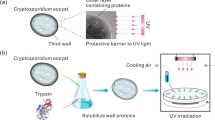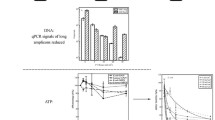Abstract
Cryptosporidium parvum is an organism that threatens public health in the water industry. It is critical to develop improved detection methods as well as disinfection methods for protecting against cryptosporidiosis, which is caused by C. parvum. In this study, we investigated the ability of pulsed-light irradiation at 200–900 nm to inactivate C. parvum. Absolute quantitative real-time PCR was performed with cDNA made from total RNA extracted from C. parvum oocysts or HCT-8 cells infected with C. parvum oocysts in vitro. C. parvum oocysts in 100-mL quartz flasks were positioned 20, 30, and 40 cm from the light source, and the duration of irradiation was either 5 or 60 s. The reductions in oocyst viability (4.9 log10) and infectivity (6 log10) were maximal when the C. parvum oocysts were irradiated 20 cm from the pulsed-light source for 60 s, for which the UV dose was 278 mJ/cm2. The minimum dose of pulsed-UV light required for effective reduction in C. parvum infectivity (2 log10) was 15 mJ/cm2, which was achieved by 5 s of irradiation at 30 cm from the light source. This study confirmed that short-duration pulsed-UV light is an effective disinfection measure for C. parvum.






Similar content being viewed by others
References
Casemore DP, Armstrong M, Sands RL (1985) Laboratory diagnosis of cryptosporidiosis. J Clin Pathol 8:1337–1341
Craik SA, Weldon D, Finch GR, Bolton JR, Belosevic M (2001) Inactivation of Cryptosporidium parvum oocysts using medium and low-pressure ultraviolet radiation. Water Res 35:1387–1398
DuPont HL, Chappell CL, Sterling CR, Okhuysen PC, Rose JB, Jakubowski W (1995) The infectivity of Cryptosporidium parvum in healthy volunteers. N Engl J Med 332:855–859
Fontaine M, Guillot E (2003) An immunomagnetic separation-real-time PCR method for quantification of Cryptosporidium parvum in water samples. J Microbiol Methods 54:29–36
Gut J, Nelson RG (1999) Cryptosporidium parvum: synchronized excystation in vitro and evaluation of sporozoite infectivity with a new lectin-based assay. J Eukaryot Microbiol 46:56S–57S
Hallier-Soulier S, Guillot E (2003) An immunomagnetic separation-reverse transcription polymerase chain reaction (IMS-RT-PCR) test for sensitive and rapid detection of viable waterborne Cryptosporidium parvum. Environ Microbiol 5:592–598
Keegan AR, Fanok S, Monis PT, Saint CP (2003) Cell culture-Taqman PCR assay for evaluation of Cryptosporidium parvum disinfection. Appl Environ Microbiol 69:2505–2511
Korich DG, Mead JR, Madore MS, Sinclair NA, Sterling CR (1990) Effects of ozone, chlorine dioxide, chlorine, and chloramine on Cryptosporidium parvum oocyst viability. Appl Environ Microbiol 56:1423–1428
Lee SU, Jung M, Ahn MH, Huh S, Song H, Park WY, Yu JR (2008) CP2 gene as a useful viability marker for Cryptosporidium parvum. Parasitol Res 102:381–387
MacDonald LM, Sargent K, Armson A, Thompson RC, Reynoldson JA (2002) The development of a real-time quantitative-PCR method for characterisation of a Cryptosporidium parvum in vitro culturing system and assessment of drug efficacy. Mol Biochem Parasitol 121:279–282
MacKenzie WR, Hoxie NJ, Proctor ME, Gradus MS, Blair KA, Peterson DE, Kazmierczak JJ, Addiss DG, Fox KR, Rose JB, Davis JP (1994) A massive outbreak in Milwaukee of Cryptosporidium infection transmitted through the public water supply. N Engl J Med 331:161–167
Mofidi AA, Baribeau H, Rochelle PA, De Leon R, Coffey BM, Green JF (2001) Disinfection of Cryptosporidium parvum with polychromatic UV light. J Am Water Works Assoc 93:95–109
Morita S, Namikoshi A, Hirata T, Oguma K, Katayama H, Ohgaki S, Motoyama N, Fujiwara M (2002) Efficacy of UV irradiation in inactivating Cryptosporidium parvum oocysts. Appl Environ Microbiol 68:5387–5393
Nichols GL (2000) Food-borne protozoa. Br Med Bull 56:209–235
O’Hara SP, Yu JR, Lin JJ (2004) A novel Cryptosporidium parvum antigen, CP2, preferentially associates with membranous structures. Parasitol Res 92:317–327
Okhuysen PC, Chappell CL, Crabb JH, Sterling CR, DuPont HL (1999) Virulence of three distinct Cryptosporidium parvum isolates for healthy adults. J Infect Dis 180:1275–1281
Petry F, Robinson HA, McDonald V (1995) Murine infection model for maintenance and amplification of Cryptosporidium parvum oocysts. J Clin Microbiol 33:1922–1924
Rochelle PA, Marshall MM, Mead JR, Johnson AM, Korich DG, Rosen JS, DeLeon R (2002) Comparison of in vitro cell culture and a mouse assay for measuring infectivity of Cryptosporidium parvum. Appl Environ Microbiol 68:3809–3817
Rochelle PA, Upton SJ, Montelone BA, Woods K (2005) The response of Cryptosporidium parvum to UV light. Trends Parasitol 21:81–87
Rowan NJ, Macgregor SJ, Anderson JG, Fouacre RA, McIlcilvaney L (1999) Pulsed-light inactivation of food-related microorganisms. Appl Environ Microbiol 65:1312–1315
Shin GA, Linden KG, Arrowood MJ, Sobsey MD (2001) Low-pressure UV inactivation and DNA repair potential of Cryptosporidium parvum oocysts. Appl Environ Microbiol 67:3029–3032
Simmons OD, Sobsey MD, Heaney CD, Schaefer FW, Francy DS (2001) Concentration and detection of cryptosporidium oocysts in surface water samples by method 1622 using ultrafiltration and capsule filtration. Appl Environ Microbiol 67:1123–1127
Stinear T, Matusan A, Hines K, Sandery M (1996) Detection of a single viable Cryptosporidium parvum oocyst in environmental water concentrated by reverse transcription PCR. Appl Environ Microbiol 62:3385–3390
Upton SJ, Tilley M, Brillhart DB (1995) Effects of select medium supplements on in vitro development of Cryptosporidium parvum in HCT-8 cells. J Clin Microbiol 33:371–375
Verweij JJ, Blange RA, Templeton K, Schinkel J, Brienen EA, van Rooyen MA, van Lieshout L, Polderman AM (2004) Simultaneous detection of Entamoeba histolytica, Giardia lamblia, and Cryptosporidium parvum in fecal samples by using multiplex real-time PCR. J Clin Microbiol 42:1220–1223
Wang T, MacGregor SJ, Anderson JG, Woolsey GA (2005) Pulsed ultra-violet inactivation spectrum of Escherichia coli. Water Res 39:2921–2925
Yang S, Healey MC (1993) The immunosuppressive effects of dexamethasone administered in drinking water to C57BL/6N mice infected with Cryptosporidium parvum. J Parasitol 79:626–630
Yu JR, O’Hara SP, Lin JL, Dailey ME, Cain G, Lin JL (2002) A common oocyst surface antigen of Cryptosporidium recognized by monoclonal antibodies. Parasitol Res 88:412–420
Zimmer JL, Slawson RM, Huck PM (2003) Inactivation and potential repair of Cryptosporidium parvum following low- and medium-pressure ultraviolet irradiation. Water Res 37:3517–3523
Acknowledgment
This paper was supported by the Korea Ministry of Environment as “The Eco-technopia 21 project” in 2006 and by the program of Basic Atomic Energy Research Institute (BAERI), which is a part of the Nuclear R & D Programs funded by the Ministry of Science & Technology (MOST) of Korea in 2007.
Author information
Authors and Affiliations
Corresponding author
Rights and permissions
About this article
Cite this article
Lee, SU., Joung, M., Yang, DJ. et al. Pulsed-UV light inactivation of Cryptosporidium parvum . Parasitol Res 102, 1293–1299 (2008). https://doi.org/10.1007/s00436-008-0908-5
Received:
Accepted:
Published:
Issue Date:
DOI: https://doi.org/10.1007/s00436-008-0908-5




